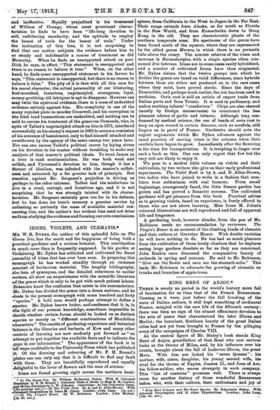IRISES, VIOLETS, AND CLEMATIS.*
Ms. W. R. DYKES, the author of this splendid folio on The Genus Iris, has the merit and the happiness of being both a practical gardener and a serious botanist. This combination is much rarer than is frequently supposed. In his garden at Godalming Mr. Dykes has collected and cultivated the fittest 'Assembly of irises that has ever been seen. In preparing this monograph he has worked steadily through an immense Amount of herbarium material The lengthy bibliography, ,the lists of synonyms, and the detailed references to earlier dwriters, all show an acquaintance with the scientific literature of the genus which is only to be got with much patient labour. -Botanists know the confusion that exists in iris nomenclature. -Mr. Dykes has divided the genus into a dozen sections, and he deals in the present monograph with some hundred and forty 4‘ species." A bold man would perhaps attempt to define a species. Mr. Dykes knows better, and confesses that it is, in the light of our present knowledge, sometimes impossible to decide whether certain forms should be looked on as distinct .species or merely as " different combinations of Mendelian schameters." The results of gardening experience and botanical 'labours in the libraries and herbaria of Kew and many other -.centres of learning are now modestly put forward as " an "attempt to put together the available facts and to indicate the gaps in our information." The appearance of the book is in 'all ways creditable to the University Press which has published -it. Of the drawing and colouring of Mr. F. H. Round's 'plates one can only say that it is difficult to find any fault ;with them. They are beautifully reproduced and equally ',delightful to the lover of flowers and the man of science.
Irises are found growing right across the northern hemi-
• (1) The Genus Iris. By William Rickatr,on Dykes. With 47 Coloured .13nasrilam by F. H. Bound, 1 Coloured Plate of Seeds by Miss B. M. Cardew, and 30 line Drawings by C. W. Johnson. Cambridge : At the University Press. ' Six guineas net.] — (2) The Violet Book. By A. and D. Allen-Brown. With Illustrations by Irene M. Johns. London: John Lane. [5s. net.] —(3) The Viryin'd Bower. By W. Robinson. London John Murray.
[Si. 6d. net.}
sphere, from California in the West to Japanin. the Far East.. Their range extends from Alaska, as far south as Florida in the New World, and from Kamschatka down to Hong Kong in the old. They are characteristic plants of the northern temperate zone. No specimens of the genus have been found south of the equator, where they are represented by the allied genus Moraea, in which there is no perianth tube above the ovary. The nearest relative of the irises and moraeas is Bermodaetylus, with a single species often mis- named Iris tuberosa. Irises are in some cases easily hybridized, and a number of cultivated forms have thus originated. Mr. Dykes claims that the twelve groups into which he divides the genus are based on valid differences, since hybrids between them are either not produced or, in the rare cases where they exist, have proved sterile. Since the days of Dioscorides, and perhaps much earlier, the iris has been used in medicine. Orris root is still an article of export trade from Italian ports and from Trieste. It is used in perfumery, and makes teething infants' "comforters." Chips are also chewed (mostly by foreign menservants) to counteract the leas pleasant odours of garlic and tobacco. Although long con. demned by medical science, the use of beads of orris root to keep an open wound in certain diseases, such as scrofula, still lingers on in parts- of France. Gardeners should note the cogent arguments which Mr. Dykes advances against the usual practice of moving irises in the autumn when their rootlets have begun to grow. Immediately after the flowering is the time for transportation. It is tempting to linger over such a book as this. One can only regret that few but the very rich are likely to enjoy it.
We pass to a modest little volume on violets and their cultivation, by two writers who give us their early professional experiences. The Violet Book is by A. and D. Allen-Brown, two ladies who have joined to write in a fashion that com- bines true enthusiasm with real humour. From small beginnings, courageously faced, the little Sussex garden has grown and has proved a financial success. The cultivated gardener will get pleasure from this book. Practical advice as to growing violets, based on experience, is freely offered to those who are not above learning. Miss Irene M. Johns's coloured illustrations are well reproduced and full of apparent life and fragrance.
A gardening book, however slender, from the pen of Mr. Robinson needs no recommendation by reviewers. The Virgin's Bower is an account of the climbing kinds of clematis and their culture at Gravetye Manor. With double varieties he will have nothing to do. He has had so much pleasure from the cultivation of these lovely climbers that he deplores seeing large gardens desolate so far as they are concerned. John Ruskin once discussed the comparative beauty of orchards in spring and autumn. He said to Mr. Robinson, " Give me the flower and save me the stomach-ache." This leads Mr. Robinson to advocate the growing of clematis on trunks and branches of apple-trees.










































 Previous page
Previous page